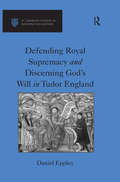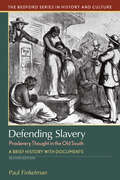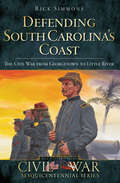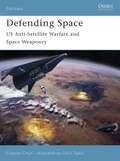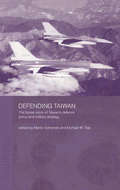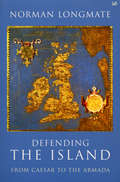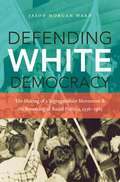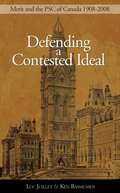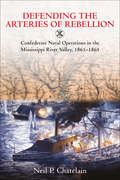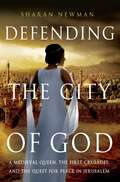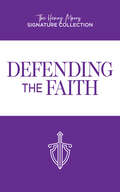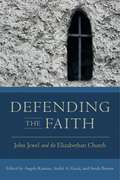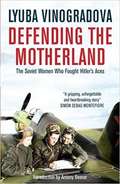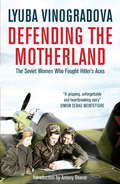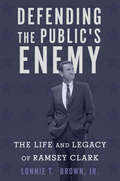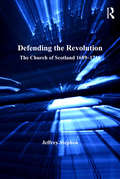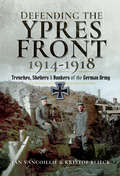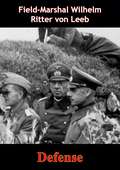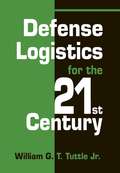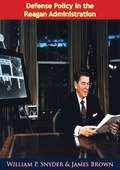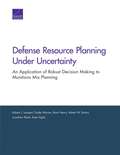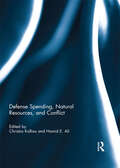- Table View
- List View
Defending Royal Supremacy and Discerning God's Will in Tudor England (St Andrews Studies in Reformation History)
by Daniel EppleyEarly modern governments constantly faced the challenge of reconciling their own authority with the will of God. Most acknowledged that an individual's first loyalty must be to God's law, but were understandably reluctant to allow this as an excuse to challenge their own powers where interpretations differed. As such, contemporaries gave much thought to how this potentially destabilising situation could be reconciled, preserving secular authority without compromising conscience. In this book, the particular relationship between the Tudor supremacy over the Church and the hermeneutics of discerning God's will is highlighted and explored. This topic is addressed by considering defences of the Henrician and Elizabethan royal supremacies over the English church, with particular reference to the thoughts and writings of Christopher St. German, and Richard Hooker. Both of these men were in broad agreement that it was the responsibility of English Christians to subordinate their subjective understandings of God's will to the interpretation of God's will propounded by the church authorities. St. German originally put forward the proposition that king in parliament, as the voice of the community of Christians in England, was authorized to definitively pronounce regarding God's will; and that obedience to the crown was in all circumstances commensurate with obedience to God's will. Salvation, as envisioned by St. German and Hooker, was thus not dependent upon adherence to a single true faith. Rather it was conditional upon a sincere effort to try to discern the true faith using the means that God had made available to the individual, particularly the collective wisdom of one's church speaking through its representatives. In tackling this fascinating dichotomy at the heart of early modern government, this study emphasizes an aspect of the defence of royal supremacy that has not heretofore been sufficiently appreciated by modern scholars, and invites consideration of how this aspect of hermeneutics is relevant to wider discussions relating to the nature of secular and divine authority.
Defending Slavery: A Brief History with Documents
by Paul FinkelmanThis new edition of Defending Slavery: Proslavery Thought in the Old South introduces the vast number of ways in which educated Southern thinkers and theorists defended the institution of slavery. This book collects and explores the elaborately detailed pro-slavery arguments rooted in religion, law, politics, science, and economics. In his introduction, now updated to include the relationship between early Christianity and slavery, Paul Finkelman discusses how early world societies legitimized slavery, the distinction between Northern and Southern ideas about slavery, and how the ideology of the American Revolution prompted the need for a defense of slavery. The rich collection of documents allows for a thorough examination of these ideas through poems, images, speeches, correspondences, and essays. This edition features two new documents that highlight women’s voices and the role of women in the movement to defend slavery plus a visual document that demonstrates how the notion of black inferiority and separateness was defended through the science of the time. Document headnotes and a chronology, plus updated questions for consideration and selected bibliography help students engage with the documents to understand the minds of those who defended slavery. Available in print and e-book formats.
Defending South Carolina's Coast: The Civil War from Georgetown to Little River (Civil War Sesquicentennial Series)
by Rick SimmonsIn Defending South Carolina's Coast: The Civil War from Georgetown to Little River, area native Rick Simmons relates the often overlooked stories of the upper South Carolina coast during the Civil War. As a base of operations for more than three thousand troops early in the war and the site of more than a dozen forts, almost every inch of the coast was affected by and hotly contested during the Civil War. From the skirmishes at Fort Randall in Little River and the repeated Union naval bombardments of Murrells Inlet to the unrealized potential of the massive fortifications at Battery White and the sinking of the USS Harvest Moon in Winyah Bay, the region's colorful Civil War history is unfolded here at last.
Defending Space
by Clayton Chun Chris TaylorThe United States has been developing space for many years, and satellites provide the US military with an unparalleled advantage over adversaries. Constellations of both military and civilian satellites provide protection and support for military operations, deliver ballistic missile early warning, supply reliable, secure and jam-proof communications, gather audio-visual amd electronic intelligence, predict weather patterns, guide navigation, target weapons, and perform a host of other missions. These systems are critical to America's status as a world power, and potential threats to them are carefully assessed by US military planners. In January 2001, a commission led by Donald Rumsfeld warned of the growing threat to US space assets from so-called "rogue states," who (with varying degrees of difficulty) might build and deploy "space mines", launch ballistic anti-satellite weapons, deliberately increase orbital debris or detonate high-altitude nuclear explosions. The defensive options currently available to the US include improving satellite defenses (making them more robust and maneuverable, and improving threat detection) and the controversial placing of weapons in space (in "sentinel satellites") to protect military and civilian hardware. Since the 1950s research and development has been applied to space weaponry with mixed results, and not only by the USA. This book explains the origin and development of systems used to defend the United States from past, present and future threats, and to support military operations.
Defending Taiwan: The Future Vision of Taiwan's Defence Policy and Military Strategy
by Martin Edmonds Michael M. TsaiRecent concern about mainland China's intentions towards Taiwan, and more general concern about the risk of instability in the region, has led to growing interest in Taiwan's military strategy, in how Taiwan perceives threats to itself, and in how the Taiwanese military are reacting to these perceived threats. This book, which includes contributions by leading Taiwanese military thinkers, explores current military strategy in Taiwan and how it is evolving. It discusses Taiwan's military modernisation, and the implications of the recent defeat after fifty years in power of the Kuomintang Party, implications which include a move away from an authoritarian garrison state culture, and the beginnings of a more open debate about defence. The book concludes with an overall appraisal of Taiwan's defence vision and makes recommendations on how Taiwan's defence might be enhanced.
Defending The Island: From Caesar to the Armada
by Norman LongmateIn a brilliantly imaginative blend of military, social and diplomatic history, Norman Longmate retells our island story from the perspective of its defenders, in a narrative which stretches from the Celtic tribes who unsuccessfully fought against Ceasar to the great seabourne defence against the Armada of Philip of Spain. He has gone back to the original sources and investigated the original battlegrounds and weak spots in Britain's defences. But the real strength of his book is its seamless narrative of history, which uncovers the truth behind the legends. A mass of solidly researched fact, not readily found elsewhere, is seasoned with lively, humorous and occassionally gruesome anecdote. The result, providing at once an invaluable sourcebook for the specialist and an enthralling narrative for the general reader, is by far the most comprehensive and accessible history of England versus invasion ever published.
Defending White Democracy
by Jason Morgan WardAfter the Supreme Court ruled school segregation unconstitutional in 1954, southern white backlash seemed to explode overnight. Journalists profiled the rise of a segregationist movement committed to preserving the "southern way of life" through a campaign of massive resistance. In Defending White Democracy, Jason Morgan Ward reconsiders the origins of this white resistance, arguing that southern conservatives began mobilizing against civil rights some years earlier, in the era before World War II, when the New Deal politics of the mid-1930s threatened the monopoly on power that whites held in the South.As Ward shows, years before "segregationist" became a badge of honor for civil rights opponents, many white southerners resisted racial change at every turn--launching a preemptive campaign aimed at preserving a social order that they saw as under siege. By the time of the Brown decision, segregationists had amassed an arsenal of tested tactics and arguments to deploy against the civil rights movement in the coming battles. Connecting the racial controversies of the New Deal era to the more familiar confrontations of the 1950s and 1960s, Ward uncovers a parallel history of segregationist opposition that mirrors the new focus on the long civil rights movement and raises troubling questions about the enduring influence of segregation's defenders.
Defending a Contested Ideal: Merit and the Public Service Commission, 1908–2008 (Governance Series)
by Luc Juillet Ken RasmussenIn 1908, after decades of struggling with a public administration undermined by systemic patronage, the Canadian parliament decided that public servants would be selected on the basis of merit, through a system administered by an independent agency: the Public Service Commission of Canada. This history, celebrating the 100th anniversary of the Commission, recounts its unique contribution to the development of an independent public service, which has become a pillar of Canadian parliamentary democracy.
Defending the Arteries of Rebellion: Confederate Naval Operations in the Mississippi River Valley, 1861–1865
by Neil P. ChatelainThis thorough account of the South’s efforts to hold the Mississippi River is “fast-paced, easy to read, and well supported by archival research”(The Civil War Monitor).Most studies of the Mississippi River focus on Union campaigns to open and control it, while overlooking Southern attempts to stop them. This book tells the other side of the story—the first modern full-length treatment of inland naval operations from the Confederate perspective.Jefferson Davis realized the value of the Mississippi River and its entire valley, which he described as the “great artery of the Confederacy.” This was the key internal highway that controlled the fledgling nation’s transportation network. Davis and his secretary of the navy knew these vital logistical paths offered potential highways of invasion for Union warships and armies to stab their way deep into the heart of the Confederacy, and had to be held.They planned to protect these arteries of rebellion by crafting a ring of powerful fortifications supported by naval forces. Different military branches, however, including the navy, marine corps, army, and revenue service, as well as civilian privateers and even state naval forces, competed for scarce resources to operate their own vessels. A lack of industrial capacity further complicated Confederate efforts and guaranteed the South’s grand vision of deploying dozens of river gunboats and powerful ironclads would never be fully realized.Despite these limitations, the Southern war machine introduced many innovations and alternate defenses including the Confederacy’s first operational ironclad, the first successful use of underwater torpedoes, widespread use of army-navy joint operations, and the employment of extensive river obstructions. When the river came under complete Union control in 1863, Confederate efforts shifted to its many tributaries, and a bitter, deadly struggle to control these internal lifelines. Despite a lack of ships, material, personnel, funding, and unified organization, the Confederacy fought desperately and scored many localized tactical victories—often at great cost—but failed at the strategic level.Written by a former Navy Surface Warfare Officer, this study, grounded in extensive archival and firsthand accounts, official records, and a keen understanding of terrain and geography, “very astutely gets to the heart of the main internal factors that lay behind the CSN's catastrophic failure to defend the strategic waterways of the Mississippi River Valley” (Civil War Books and Authors).
Defending the City of God
by Sharan NewmanJerusalem sits at the crossroads of three continents and has been continuously invaded for millennia. Yet, in the middle of one of the region's most violent eras, the Crusades, an amazing multicultural world was forming. Templar knights, Muslim peasants, Turkish caliphs, Jewish merchants, and the native Christians, along with the children of the first crusaders, blended cultures while struggling to survive in a land constantly at war. Defending the City of God explores this fascinating and forgotten world, and how a group of sisters, daughters of the King of Jerusalem, whose supporters included Grand Masters of the Templars and Armenian clerics, held together the fragile treaties, understandings, and marriages that allowed for relative peace among the many different factions. As the crusaders fought to maintain their conquests, these relationships quickly unraveled, and the religious and cultural diversity was lost as hardline factions took over. Weaving together the political intrigues and dynastic battles that transformed the Near East with an evocative portrait of medieval Jerusalem, this is an astonishing look at a forgotten side of the first Crusades.
Defending the Faith (The Henry Morris Signature Collection)
by Dr Henry MorrisEQUIP YOURSELF…AND BE READY TO GIVE AN ANSWER FOR YOUR FAITH Examine scientific disciplines from a young earth and worldwide Flood approach Identify the weaknesses in origin theories that ignore God Learn how to rebut theories of atheistic scientism that compromise biblical truth Have you ever been faced with an argument rejecting the doctrine of special creation and a global Flood? Were you left scrambling for an answer? In Defending the Faith, Henry Morris presents the evolutionary and Bible-compromising arguments for the origins of the earth and universe — then reveals their many flaws through sound evidence and logic. This book will prepare you to refute, both scientifically and biblically, evolutionary claims as well as “Christian” concepts such as the gap and day-age theories. Equipped with such knowledge, you will “be ready always to give an answer to every man that asketh you a reason of the hope that is in you” (1 Peter 3:15).
Defending the Faith: John Jewel and the Elizabethan Church (Early Modern Studies)
by Angela Ranson André A. Gazal Sarah BastowThis volume brings together a diverse group of Reformation scholars to examine the life, work, and enduring significance of John Jewel, Bishop of Salisbury from 1560 to 1571.A theologian and scholar who worked with early reformers in England such as Peter Martyr Vermigli, Martin Bucer, and Thomas Cranmer, Jewel had a long-lasting influence over religious culture and identity. The essays included in this book shed light on often-neglected aspects of Jewel’s work, as well as his standing in Elizabethan culture not only as a priest but as a leader whose work as a polemicist and apologist played an important role in establishing the authority and legitimacy of the Elizabethan Church of England. The contributors also place Jewel in the wider context of gender studies, material culture, and social history. With its inclusion of a short biography of Jewel’s early life and a complete list of his works published between 1560 and 1640, Defending the Faith is a fresh and robust look at an important Reformation figure who was recognized as a champion of the English Church, both by his enemies and by his fellow reformers.In addition to the editors, contributors to this volume are Andrew Atherstone, Ian Atherton, Paul Dominiak, Alice Ferron, Paul A. Hartog, Torrance Kirby, W. Bradford Littlejohn, Aislinn Muller, Joshua Rodda, and Lucy Wooding.
Defending the Faith: John Jewel and the Elizabethan Church (Early Modern Studies)
by Angela RansonThis volume brings together a diverse group of Reformation scholars to examine the life, work, and enduring significance of John Jewel, bishop of Salisbury from 1560 to 1571.A theologian and scholar who worked with early reformers in England such as Peter Martyr Vermigli, Martin Bucer, and Thomas Cranmer, Jewel had a long-lasting influence over religious culture and identity. The essays included in this book shed light on often-neglected aspects of Jewel’s work, as well as his standing in Elizabethan culture not only as a priest but as a leader whose work as a polemicist and apologist played an important role in establishing the authority and legitimacy of the Elizabethan Church of England. The contributors also place Jewel in the wider context of gender studies, material culture, and social history. With its inclusion of a short biography of Jewel’s early life and a complete list of his works published between 1560 and 1640, Defending the Faith is a fresh and robust look at an important Reformation figure who was recognized as a champion of the English Church, both by his enemies and by his fellow reformers.In addition to the editors, contributors to this volume are Andrew Atherstone, Ian Atherton, Paul Dominiak, Alice Ferron, Paul A. Hartog, Torrance Kirby, W. Bradford Littlejohn, Aislinn Muller, Joshua Rodda, and Lucy Wooding.
Defending the Land of the Jaguar
by Lane SimonianMexican conservationists have sometimes observed that it is difficult to find a country less interested in the conservation of its natural resources than is Mexico. Yet, despite a long history dedicated to the pursuit of development regardless of its environmental consequences, Mexico has an equally long, though much less developed and appreciated, tradition of environmental conservation. Lane Simonian here offers the first panoramic history of conservation in Mexico from pre-contact times to the current Mexican environmental movement. He explores the origins of conservation and environmental concerns in Mexico, the philosophies and endeavors of Mexican conservationists, and the enactment of important conservation laws and programs. This heretofore untold story, drawn from interviews with leading Mexican conservationists as well as archival research, will be important reading throughout the international community of activists, researchers, and concerned citizens interested in the intertwined issues of conservation and development.
Defending the Motherland: The Soviet Women Who Fought Hitler's Aces
by Lyuba VinogradovaPlucked from every background, and led by an N.K.V.D. Major, the new recruits who boarded a train in Moscow on 16th October 1941 to go to war had much in common with millions of others across the world. What made the 586th Fighter Regiment, the 587th Heavy-bomber Regiment and the 588th Regiment of light night-bombers unique was their gender: the Soviet Union was creating the first all-female active combat units in modern history.Drawing on original interviews with surviving airwomen, Lyuba Vinogradova weaves together the untold stories of the female Soviet fighter pilots of the Second World War. From that first train journey to the last tragic disappearance, Vinogradova's panoramic account of these women's lives follows them from society balls to unmarked graves, from landmark victories to the horrors of Stalingrad. Battling not just fearsome Aces of the Luftwaffe but also patronising prejudice from their own leaders, women such as Lilya Litvyak and Ekaterina Budanova are brought to life by the diaries and recollections of those who knew them, and who watched them live, love, fight and die.
Defending the Motherland: The Soviet Women Who Fought Hitler's Aces
by Lyuba VinogradovaPlucked from every background, and led by an N.K.V.D. Major, the new recruits who boarded a train in Moscow on 16th October 1941 to go to war had much in common with millions of others across the world. What made the 586th Fighter Regiment, the 587th Heavy-bomber Regiment and the 588th Regiment of light night-bombers unique was their gender: the Soviet Union was creating the first all-female active combat units in modern history.Drawing on original interviews with surviving airwomen, Lyuba Vinogradova weaves together the untold stories of the female Soviet fighter pilots of the Second World War. From that first train journey to the last tragic disappearance, Vinogradova's panoramic account of these women's lives follows them from society balls to unmarked graves, from landmark victories to the horrors of Stalingrad. Battling not just fearsome Aces of the Luftwaffe but also patronising prejudice from their own leaders, women such as Lilya Litvyak and Ekaterina Budanova are brought to life by the diaries and recollections of those who knew them, and who watched them live, love, fight and die.
Defending the Motherland: The Soviet Women Who Fought Hitler's Aces
by Lyuba VinogradovaPlucked from every background, and led by an N.K.V.D. Major, the new recruits who boarded a train in Moscow on 16th October 1941 to go to war had much in common with millions of others across the world. What made the 586th Fighter Regiment, the 587th Heavy-bomber Regiment and the 588th Regiment of light night-bombers unique was their gender: the Soviet Union was creating the first all-female active combat units in modern history.Drawing on original interviews with surviving airwomen, Lyuba Vinogradova weaves together the untold stories of the female Soviet fighter pilots of the Second World War. From that first train journey to the last tragic disappearance, Vinogradova's panoramic account of these women's lives follows them from society balls to unmarked graves, from landmark victories to the horrors of Stalingrad. Battling not just fearsome Aces of the Luftwaffe but also patronising prejudice from their own leaders, women such as Lilya Litvyak and Ekaterina Budanova are brought to life by the diaries and recollections of those who knew them, and who watched them live, love, fight and die.
Defending the Public's Enemy: The Life and Legacy of Ramsey Clark
by Lonnie T. BrownWhat led a former United States Attorney General to become one of the world's most notorious defenders of the despised? Defending the Public's Enemy examines Clark's enigmatic life and career in a quest to answer this perplexing question. The culmination of ten years of research and interviews, Lonnie T. Brown, Jr. explores how Clark evolved from our government's chief lawyer to a strident advocate for some of America's most vilified enemies. Clark's early career was enmeshed with seminally important people and events of the 1960s: Martin Luther King, Jr., Watts Riots, Selma-to-Montgomery March, Black Panthers, Vietnam. As a government insider, he worked to secure the civil rights of black Americans, resisting persistent, racist calls for more law and order. However, upon entering the private sector, Clark seemingly changed, morphing into the government's adversary by aligning with a mystifying array of demonized clients—among them, alleged terrorists, reputed Nazi war criminals, and brutal dictators, including Saddam Hussein. Is Clark a man of character and integrity, committed to ensuring his government's adherence to the ideals of justice and fairness, or is he a professional antagonist, anti-American and reflexively contrarian to the core? The provocative life chronicled in Defending the Public's Enemy is emblematic of the contradictions at the heart of American political history, and society's ambivalent relationship with dissenters and outliers, as well as those who defend them.
Defending the Revolution: The Church of Scotland 1689–1716
by Jeffrey StephenThe 'Glorious Revolution' of 1688-90 played a fundamental role in re-shaping the political, religious and cultural map of the British Isles. Yet, as this book demonstrates, many key elements of the history of the period between the landing of William of Orange and the establishment of the Union between Scotland and England, remain shadowy. In particular, the religious and theological underpinnings of the Revolution in Scotland have received scant attention compared to discussions of events in England, and Ireland. This book sets out to show how the religious dimension of the revolution settlement in Scotland while comprehensively Presbyterian, was not inevitable, revealing instead the degree of political and religious pressure that was brought to bear in order to press for a moderate settlement that took cognizance of the Episcopalian position. However, the outcome demonstrated the ability of Presbyterians to respond to the changing political circumstances and seize the opportunities they offered, enabling them to galvanise their support within parliament and secure a settlement that went beyond what William and Erastian-inclined Presbyterians would have preferred. Traditionally, treatment of the religious outcome in Scotland has been restricted to a bare narration of the significant acts of parliament - this book takes a more thorough and critical approach to explain not only the nature of the final settlement but how it was achieved, and the legacy it left for both Scotland and the newly forged British state.
Defending the Ypres Front, 1914–1918: Trenches, Shelters & Bunkers of the German Army
by Jan Vancoillie Kristof BlieckPublished by the Memorial Museum Passchendaele in 2016 in Dutch as Bouwen aan het front, this book examines how the German army developed field fortifications to hold what can loosely be described as the Ypres Front. With the decision by Falkenhayn in 1915 to concentrate Germanys offensive efforts largely in the east, the German defenders around Ypres set to developing their lines for semi-permanent occupation. The sub soil around the Salient generally made it difficult to construct and maintain mined (i.e. deep) dugouts—unlike on, for example the Somme, with easily worked chalk not far below the surface. The only practicable alternative was to use reinforced concrete.In this book the authors (both with many years of experience in researching and working on matters Great War, particularly the German army in Belgium) have examined in detail an impressive range of primary sources to provide a narrative of what the Germans built, how they built it (the logistical challenge was enormous) and how the designs and requirements of bunkers (for example, forward medical bunkers, artillery shelters, machine gun and observation bunkers) changed as the war progressed and as the military situation on the front dictated. There are many photographs, largely unseen by British readers, design diagrams and maps to supplement the text; whilst the activities of selected particular formations are examined in detail to provide an example of the effort that was put into the work.Additions to the Dutch edition will include a tours section, taking a visitor to accessible remaining structures in the Salient area; and a glossary of terms and their English equivalent. The book will be in full color throughout.
Defense
by Field-Marshal Wilhelm Ritter von Leeb"THE principles of conduct of war and conduct of combat as expounded in this book by Field Marshal General Ritter Wilhelm von Leeb were written only a few years before the present war."Von Leeb realistically and meticulously examined and re-examined the existing conceptions of defense to analyze what of value remained from World War I. He originally published his theories in the Militärwissenschaftliche Rundschau ("The Scientific Military Review") of the German War Office. They were later issued in book form, under the title Die Abwehr, in Berlin in 1938, and appear for the first time in English translation in this work."In his DEFENSE von Leeb, as a military thinker and scientist, comparable to any of the outstanding authorities of the old German army--Schlieffen, Falkenhayn, Groner, Seeckt, etc.--offered his government a plan for the next war in which Germany might be engaged. It is estimated by competent judges as probably "the most important piece of research in the field of strategy and tactics in modern warfare that has appeared in a decade.""
Defense Logistics for the 21st Century
by William Tuttle Jr.The last comprehensive study of defense logistics was published in 1959. In the ensuing forty-five years a revolutionary change in information technology and defense strategy has swept the field and mandated a new understanding of the objectives and principles of military logistics. The author, renowned defense logistics expert General William Tuttle, covers all aspects of the subject including force projection, force sustainment, and minimizing the logistics "footprint" in battle spaces. Within these objectives, he includes five principles that are employed to assess the effectiveness of the process and identifies their shortfalls and remedies. He also illuminates the major influences of culture and politics on defense logistics and proposes ways to minimize their adverse impact on combat readiness. Written for defense logistics leaders - those currently coping with the challenges and those logistics aspiring to lead - and for everyone involved in the complexities of planning and strategy, this up-to-date volume is sure to become a hallmark in the field.
Defense Policy in the Reagan Administration
by William P. SnyderBy substantially increasing defense budgets, the Reagan Admin. (RA) did more than merely underwrite improvements in military forces, it undertook initiatives that changed both the image and reality of America's national defense. This book examines: the Strategic Defense Initiative, the 600 ship Navy, and the hefty increase in the Defense budget. Critics and supporters of the RA do agree on one point: the RA came into office with the intent of strengthening defense policy. How well the RA succeeded in that effort and the cost of that success are debated here.
Defense Resource Planning Under Uncertainty
by Robert J. Lempert Robert W. Button Kate Giglio Ryan Henry Jonathan Klenk Drake WarrenDefense planning faces significant uncertainties. This report applies robust decision making (RDM) to the air-delivered munitions mix challenge. RDM is quantitative, decision support methodology designed to inform decisions under conditions of deep uncertainty and complexity. This proof-of-concept demonstration suggests that RDM could help defense planners make plans more robust to a wide range of hard-to-predict futures.
Defense Spending, Natural Resources, and Conflict
by Christos Kollias and Hamid E. AliThis book is an intellectual contribution of policy scientists and researchers from different academic institutions in different parts of the world. The Arab Spring, the rise of ISIS and terrorism ignite the debate on studying conflict and natural resources. Uniquely, the book discusses the sources of the conflicts and the institutions that are managing the conflicts. The natural resources, defense spending, conflict and human welfare are intertwined. In support of the ‘resource curse’ hypothesis, the book shows that an abundance of natural resources, particularly oil, encourages an increase in military spending and lower economic growth. In addition, the good economic and political institutions do reduce the hazard of conflict; and strong political institutions for checks and balances appear to weaken the impact of natural resources on conflicts.The book also examines the relationship between defense and social welfare expenditures – specifically, health and education. Shedding light on the complicated nature of the relationship between defense spending, inequality, and types of political and welfare regimes gives us a deeper understanding of the type of democratic systems that will likely improve social welfare. In studying the political economy of defense spending, the book shows the link between public opinion toward defense spending and voters' support for candidates. The analysis shows that party identification or having a vested interest in defense industries do correlate with a preference for increasing defense spending.This book was published as a special issue of Defence and Peace Economics.
